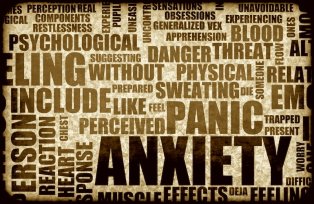 Worried About Your Anxiety Taking Over?
Worried About Your Anxiety Taking Over?
In normal circumstances each of us is likely to think worrying thoughts, feel anxious or experience fear for short periods of time now and then.
And even though we may consider them to be mostly negative experiences, they can have a positive effect too. Either by getting us to respond effectively to our immediate concerns, or to be adequately prepared for future events.
It's where anxiety, fears and worry start to regularly intrude into our life beyond what we experience as being helpful that the problems start. A process that can ultimately lead to us being diagnosed[1] with one or more of the following Anxiety Disorders[2]:-
- Generalised Anxiety Disorder (GAD) - excessive anxiety & worry about a wide range of events or situations;
- Obsessive-Compulsive Disorder (OCD) - a combination of obsessional thinking, compulsive rituals and other repetitive compensatory behaviours;
- Panic Disorder - unexpected moments of extremely high anxiety & panic that occur repeatedly;
- Social Anxiety Disorder (a.k.a. Social Phobia) - intense preoccupation with being judged harshly by others or by oneself in social situations. A number of very specific physical symptoms are often present - such as intense blushing, sweating or stammering;
- Specific Phobias - extreme and inappropriate fear of a specific animal, object, place or situation. In addition, sufferers may be anxious about the prospect of facing the subject of their intense fear, which can lead to regular and extensive avoidance behaviour - greatly affecting their quality of life;
- Post-Traumatic Stress Disorder (PTSD) - severe ongoing emotional reaction to one or more earlier traumatic events. May include flashbacks, nightmares and other forms of troublesome re-experiencing of the original event/s.
[1]: Your GP (or another suitably-qualified health professional) will be able to provide you with a formal diagnosis if you feel this is relevant to you.
[2]: As determined by the American Psychiatric Association (APA) and published in DSM-IV, the 4th edition of their Diagnostic and Statistical Manual. In the 5th edition (DSM-5) OCD and PTSD were no longer placed in the Anxiety Disorders section.
All anxiety disorders, (or perhaps more accurately fear & anxiety disorders), have one thing in common:- persistent and excessive anxiety, fear or worry in relation to situations that for most people would not be considered threatening or of great concern.
Where a formal anxiety disorder diagnosis is made it can quite often consist of at least two of the disorders listed above, and in some cases it may also coincide with depression.
Anyone who has relatively high levels of worry, anxiety and/or fear on a regular basis may be looking for some form of external support in dealing with their issues, well before their symptoms become sufficiently severe and prolonged that an anxiety disorder is diagnosed.
We experience fear and anxiety as being closely-related, and for some of us they may even seem almost identical.
Where we do make a distinction, anxiety is usually considered to be the emotional state we have in response to anticipated threats and significant concerns that are somewhat general or abstract. Whilst fear is the feeling we have when we perceive immediate, specific, very ‘real’ threats.
The more often you find yourself interpreting existing and possible future situations as potentially threatening…
The more anxious you are likely to feel.
For many people, the feeling of anxiety is an uncomfortable sense of unease or apprehension, and this is usually experienced with some or all of the following:-
- Body Sensations/Changes:
- Tense muscles, dry mouth and increased perspiration;
- Trembling, difficulty in swallowing and more rapid heartbeat;
- Greater alertness and speed of reaction.
- Behavioural Urge: Desire to avoid the threat-related event/situation entirely;
- Potential Impact on Thinking:
- Increased focus on finding threats (Hypervigilance);
- Overestimation of the likelihood of negative events and raised expectation of the severity of their consequences.
Where modest anxiety is experienced for relatively short periods of time, usually it isn’t problematic. However, sometimes the interplay between our feelings of anxiety and how we think about things can be a major factor in our anxiety becoming much longer-lasting and increasingly intense.
Anyone who is troubled by significant general anxiety issues, where they are regularly experiencing both excessive anxiety and chronic worry across many areas of our life, may have additional physical symptoms such as:-
- Thoughts & Feelings: A sense of impending doom, feeling 'on edge' and irritability;
- Body/Energy Levels: Easily fatigued and restlessness;
- Mental Functioning: Have difficulty concentrating and mind going blank;
- Chronic Sleep Issues: Severe difficulties getting to sleep or remaining asleep, and poor quality sleep;
- Bladder Problems: Need to frequently urinate;
- Other Potential Symptoms: Nausea, diarrhoea and heart flutters.
We sometimes say we are ‘worried’ when we've only had one or two concerned thoughts about a possible future event. Thoughts such as “What if [event x] happened? How am I going to be able to cope?” or “I am dreading my next meeting/conversation with [person y]”. However, we more commonly use the word ‘worry’ to describe situations where we have a series of such thoughts racing through our mind.
Where our level of worry is not a significant issue…
A reasonable proportion of our worrisome thoughts are likely to be helpful.
Helpful worrisome thoughts will tend to be quite specific and be about an event or situation that most people would think is a realistic prospect.
And if we take notice of these early-warning thoughts it will often encourage us to take appropriate action.
By taking productive action we are releasing any tension that was building up and we will feel more in control of the possible future event that was previously troubling us.
We also don't have to confront the fear and the discomfort of doing nothing. Although in some cases, quite perversely, this desire can also increase a person's level of worry and anxiety. The logic being that worrying is at least doing ‘something’, even if it doesn’t provide a solution in itself.
Interestingly, there is some research that suggests that whilst we are worrying we temporarily dampen down our stress and anxiety levels, hence a further reason for its strong attraction to some of us.
Unfortunately, soon after we stop worrying the reality hits that nothing has really changed, except the passage of time. So we are very likely to feel even more anxious as a result of this.
Our level of anxiety may increase further because we are no longer benefiting from the ‘dampening’ effect provided by us actively worrying.
A worrisome thought is helpful when it highlights a reasonably likely future problem that we care about…
and when it leads us to take productive action.
In contrast, a worrisome thought that doesn't lead to us taking action, or that we don’t consciously decide can be safely left, becomes a bigger problem. That’s because a worrisome thought that isn't dealt with effectively is likely to pop into our heads repeatedly, until and unless we do take proper notice of it.
Not dealing effectively with worrisome thoughts can, over a relatively short period time, create the conditions for us to automatically generate longer and longer series of unresolved worries on a regular basis. Which can quickly become an unhelpful and unhealthy habit.
Experiencing streams of worrying thoughts can be very tiring and it reduces the amount of time we can focus on the present. We may also have the further complication of finding it harder and harder to pinpoint which specific future events/situations seem to be contributing most to our feelings of anxiety.
And because we have less time and energy available, our feelings of stress may increase without the external demands on us being any greater.
The process of a person going from their original broadly helpful levels of anxiety, fear and worry, to having significant anxiety issues can take many years.
Not surprisingly, high levels of general anxiety and the excessive worrying that tends to go with it can be very challenging for a person to control or to influence on their own.
This is largely because…
Anyone who has developed problematic anxiety over a number of years…
will have consistently harnessed their imagination in distinctly negative ways.
When you are in the middle of worrying, all your negative worrisome thoughts will seem completely realistic. However, once you are calmer and have a better perspective on things you may see that some of those worrisome thoughts weren't valid after all.
Being able to accurately differentiate between realistic concerns and those worries that are actually due to distorted thinking can be a very helpful first step in breaking free from your unproductive worrying. As soon as you can correctly label your worries you are then in a position to re-establish far healthier patterns of thinking.
Three examples of the sort of distorted and unrealistic thinking most commonly used by people are:-
- All or Nothing Thinking:
If a distorted thinker makes a small mistake on a paper form, they think it's ‘completely ruined’ and that they have to start over. This is clearly linked to perfectionism; - Falsely Generalising:
Our brains are designed to look for patterns once a few examples of something have been experienced. A distorted thinker can experience just one disappointing outcome related to an event and then create a new mental rule that they will ‘always’ experience disappointment when a similar event occurs; - Dwelling on a Negative Detail:
When the distorted thinker has a job performance review at which five positive areas and one area for improvement are discussed, all the distorted thinker is likely to think about is the one area that requires work. By dwelling on the negative in this particular situation it becomes likely that the distorted thinker will increasingly expect and look out for further not so positive things to happen in relation to their manager. This will almost inevitably affect how they feel and behave, which in turn may make their perspective on things become more negative and influence how their manager treats them. Distorted thinking can create unhelpful downward spirals very quickly, so catching these biased patterns of thought early is the best course of action.
This sort of unrealistic negative thinking tends to be highly pronounced in chronic worriers.
Easing a person's worries is likely to reduce their anxiety and potentially give them relief…
from the various physical symptoms they may have been experiencing.
The initial thoughts and feelings we have in response to the world around us are often created outside of our conscious awareness.
It's only when our conscious rational mind becomes aware of these subconsciously-generated thoughts and feelings that we have an opportunity to take a different tack.
Our subconscious inner mind operates on the basis of repeating what seems to have worked in the past and chooses what it considers the best option available using the information it has to hand.
The inner mind makes extensive use of our existing beliefs to guide its decision-making. Typically these beliefs will include rules of personal behaviour, rules about the world and self-labels - the elements that combine to form our overall sense of self.
The thoughts, feelings and behaviour we have are all strongly linked. As a new thought is created our feelings and behaviour may change in response, and this in turn may impact on our thinking… which starts the process once again.
In order to change things in any area of our life we can either choose to work with all three of these elements in one go using vivid experiences, or we can select one element at a time to focus on - usually our thinking or our behaviour.
Q. How can we work together to address your anxiety and worry issues?
Each person's situation is unique, so the following is only an outline of some possible steps that may be beneficial in assisting you make progress using hypnotherapy.
- Improved Relaxation & Sleep
- Your problematic levels of anxiety and worry are given extra fuel if you are finding it difficult to relax and to have satisfying sleep on a regular basis.
- Hypnotherapy is able to provide considerable support in both these areas.
- Exploring Your Worrisome Thoughts
- Every chronic worrier has a set of personal rules, beliefs and strong preferences that directly contribute to their worrisome thinking such as:-
-
I can’t stand any uncertainty;
I must be well prepared at all times;
I must not fail at anything;
I must produce everything to a high standard;
All my thoughts and judgements are true;
If something needs doing it must be done immediately;
I need my preferences to be satisfied wherever possible;
I believe that the amount I worry is a sign of how much I care;
Worrying helps me cope with my anxiety;
Worrying helps me to avoid experiencing some negative emotions;
Worrying helps me to avoid some situations that I fear;
Worrying helps me to avoid taking action in my life. - However, the contributors to your worrying may be quite different from those given above.
- By focussing in on your worries we can make an assessment of the work that needs to be done. Your worries can be grouped into 3 categories:-
-
Productive Worries
Worrisome thoughts that are realistic, beneficial and that you can translate into immediate and worthwhile actions without difficulty. -
Worries Requiring No Action
Concerns that do not require any action. This is either because they are clearly unrealistic in some way or that attending to them is unimportant to you. Even people with a healthy level of worrying have concerns like these that appear from time to time - it’s not a problem. -
Other Worries
It is these concerns that we will need to explore further. Worries that you are currently unable to immediately resolve or to easily decide require no action.
-
Productive Worries
- Once we know the elements of your thinking and which of your beliefs are contributing most strongly to your problematic worrying we can aim to address them.
- These troublesome thinking patterns and beliefs will need to be replaced by more helpful beliefs and styles of thinking that sit well with you consciously and that do not conflict with other core beliefs that you hold.
- Past Experiences
- Sometimes the roots of your anxiety and worry issues will lie in the events of the past. If that's true for you, then a different approach may be needed.
- By asking your inner mind to help us find your memories of the relevant earlier experiences, we will aim to release the emotional charge around them. And following this you will be supported to re-frame the events in a more productive and healthy way.
- This process can potentially remove your emotional need to worry to excess and be overly anxious.
As with all forms of therapy - the precise results achieved may vary from person to person.









